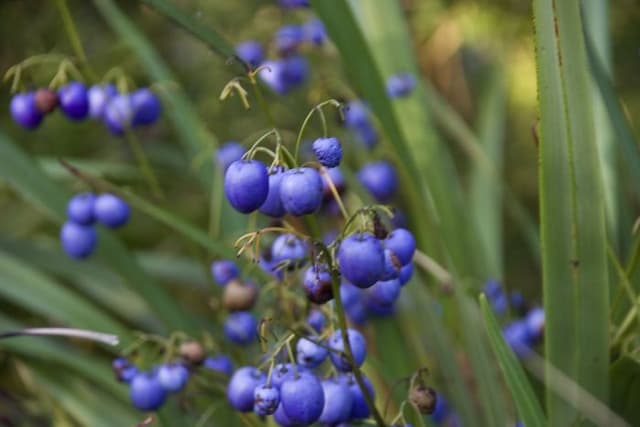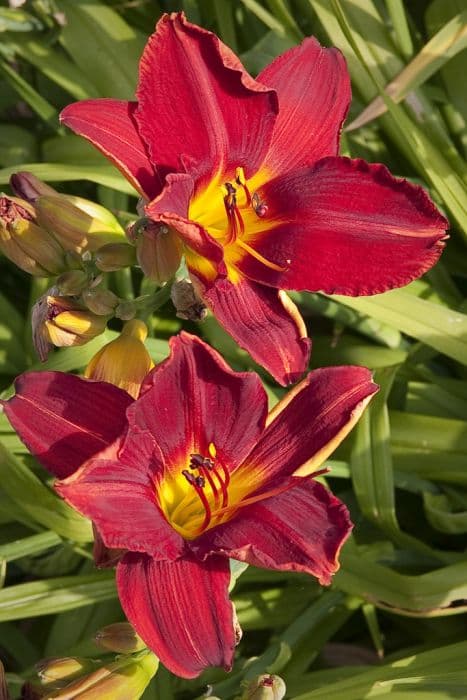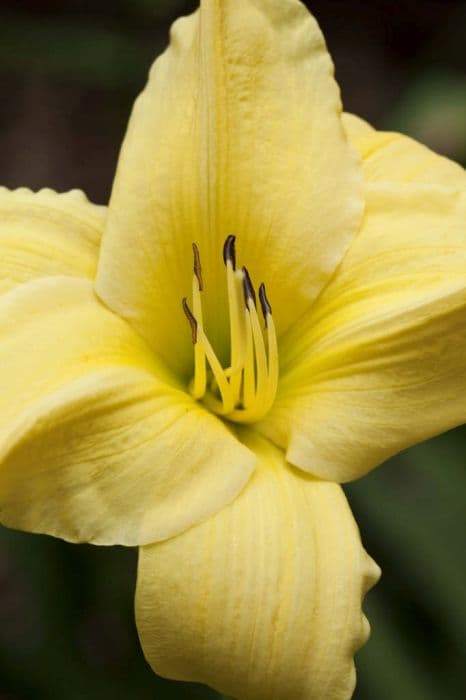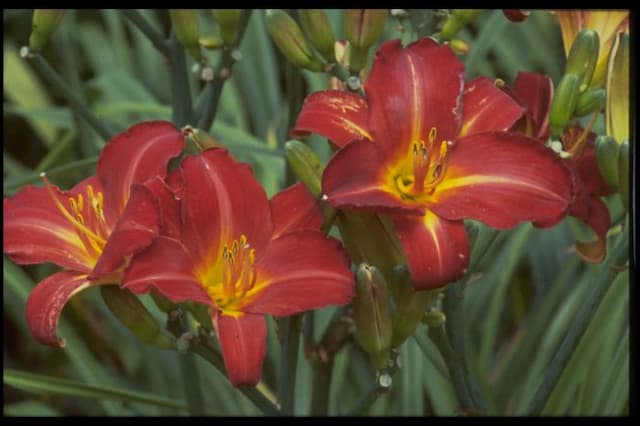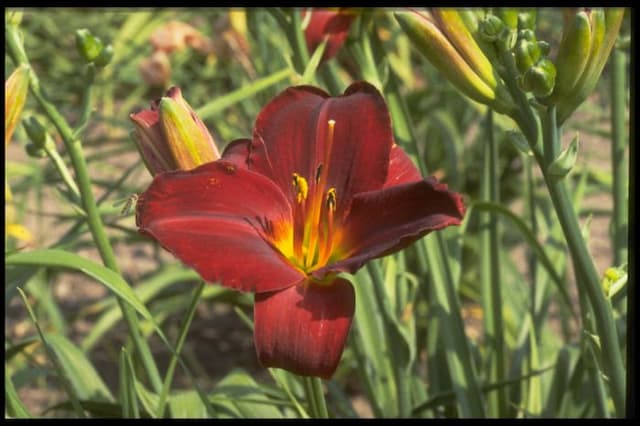Daylily Hemerocallis 'Cosmic Blast'
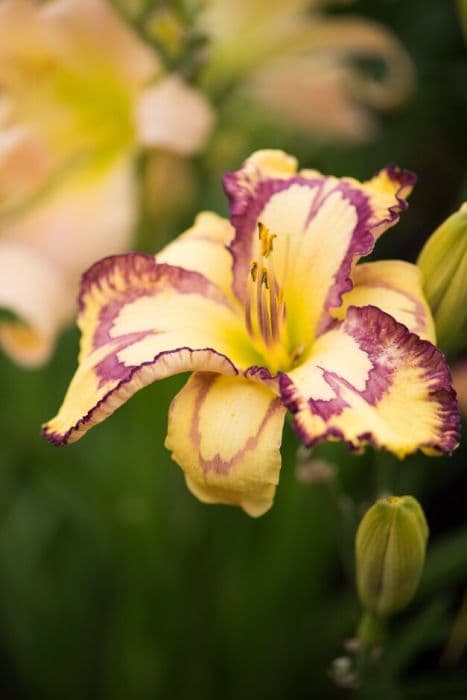
ABOUT
The Hemerocallis 'Cosmic Blast', commonly known as the Daylily, is a highly decorative perennial that is well-known for its striking blooms. This variety typically features large, ruffled petals that display a spectacular gradation of color. The vibrantly colored flowers usually blend a warm palette of reddish-orange, yellows, and often a touch of pink, giving the impression of a cosmic explosion or a sunset captured in the bloom. Each individual flower has a contrasting throat, often in a deeper, more saturated color, which adds depth and draws attention to the center of the flower. Surrounded by lush, green, grass-like foliage that forms a dense clump, the flowers stand out prominently against the background. The Daylily's blooms are known for their characteristic trumpet shape, opening wide at the mouth and narrowing at the base where they connect to long, slender stems that rise above the foliage. These stems, called scapes, elegantly support the flowers and occasionally might have multiple blooms per stem. The blooming period of the Daylily 'Cosmic Blast' is a highlight in the garden, with each individual flower typically lasting only one day, hinting at the ephemeral beauty of these remarkable plants. Nevertheless, Daylilies are prolific bloomers, and many buds on their stems ensure a continuous display of color throughout their blooming season.
About this plant
 Names
NamesFamily
Hemerocallidaceae
Synonyms
Daylily
Common names
Hemerocallis 'Cosmic Blast'.
 Toxicity
ToxicityTo humans
Daylilies, including the Hemerocallis 'Cosmic Blast', are generally considered non-toxic to humans. They are even edible and have been consumed in certain cultures for culinary purposes. However, it is always important to be cautious and ensure correct identification, as consuming the wrong plant, or parts of plants, could result in negative reactions due to individual allergies or plant misidentification.
To pets
Daylilies are toxic to cats and can cause acute kidney failure if ingested. Symptoms of daylily poisoning in cats can include vomiting, lethargy, lack of appetite, and increased urination followed by a lack of urination after 1 to 2 days. If your cat consumes any part of a daylily plant, it is crucial to seek immediate veterinary attention to prevent serious health consequences or even death. Dogs are not generally affected in the same way, but it's still advisable to prevent them from ingesting daylilies just to be safe.
 Characteristics
CharacteristicsLife cycle
Perennials
Foliage type
Deciduous
Color of leaves
Green
Flower color
Mixed
Height
2 feet (61 centimeters)
Spread
2 feet (61 centimeters)
Plant type
Herb
Hardiness zones
Varies
Native area
Asia
Benefits
 General Benefits
General Benefits- Easy to grow - Hemerocallis, commonly known as daylilies, are low maintenance and can thrive in a variety of soil conditions.
- Drought tolerant - Once established, daylilies can tolerate dry spells, making them suitable for xeriscaping.
- Long blooming - Daylilies typically have a long blooming season, providing flowers throughout the summer.
- Attracts wildlife - The flowers can attract butterflies and hummingbirds, enhancing the biodiversity of a garden.
- Variety of colors - 'Cosmic Blast' offers vibrant blooms that can add a splash of color to any landscape.
- Rapid growth - Daylilies are known for their quick growth, allowing for fast landscape coverage.
- Erosion control - The root system of daylilies can help stabilize soil and prevent erosion.
- Adaptable - They can grow in partial shade to full sun, making them versatile for different garden spots.
- Propagates easily - Daylilies can be easily divided to create more plants, offering a cost-effective way to expand a garden.
 Medical Properties
Medical PropertiesThis plant is not used for medical purposes.
 Air-purifying Qualities
Air-purifying QualitiesThis plant is not specifically known for air purifying qualities.
 Other Uses
Other Uses- Companion Planting: Used in gardens to complement other flowers, as its vibrant color can accentuate the beauty of neighboring plants.
- Gastronomy: The petals of daylilies are edible and can be used in salads or as edible garnishes for a touch of elegance to any dish.
- Natural Dye: The flowers can be used to make a natural dye for fabrics, imparting a yellow or orange hue depending on the concentration.
- Artistic Inspiration: Daylilies serve as a source of inspiration for artists and photographers, drawn to their unique form and color for various creative projects.
- Education: Daylilies are an example in horticultural studies of successful hybridization and diversity in plant breeding programs.
- Garden Aesthetics: Planted en masse, they can serve as a stunning groundcover alternative, enhancing the texture and color dynamics of a garden space.
- Cultural Events: In some areas, daylilies can be featured in flower festivals or garden shows, celebrating the beauty and variety of the species.
- Wildlife Attraction: Daylilies can attract pollinators such as butterflies and bees, which are essential for the health of a garden.
- Soil Erosion Control: Their root systems help stabilize soil, making them a functional choice for areas prone to erosion.
- Floral arrangements: Daylilies are sometimes used in cut flower arrangements, though their individual flowers last only one day, they can be a unique addition to bouquets.
Interesting Facts
 Feng Shui
Feng ShuiThe Daylily is not used in Feng Shui practice.
 Zodiac Sign Compitability
Zodiac Sign CompitabilityThe Daylily is not used in astrology practice.
 Plant Symbolism
Plant Symbolism- Beauty and Elegance: Hemerocallis, commonly known as the Daylily, often symbolizes beauty and elegance due to its vibrant flowers and graceful form.
- Fleeting Nature of Life: As each flower typically lasts for only one day, Daylilies can represent the fleeting nature of life, reminding us to cherish every moment.
- Motherhood: In Chinese culture, Daylilies are associated with motherhood and the devotion of mothers because of their nurturing way of continuously producing flowers.
- Renewal and New Beginnings: The Daylily's daily bloom cycle signifies renewal and the hope for new beginnings, perfect for symbolizing fresh starts.
- Forgiveness: With its ability to produce new flowers after the old ones have faded, Daylilies can symbolize forgiveness and the ability to move on from past grievances.
- Survival and Adaptability: Given Daylilies' hardiness and ability to thrive in a variety of conditions, they can represent survival, adaptability, and resilience.
 Water
WaterDaylilies, such as the Hemerocallis 'Cosmic Blast', should be watered deeply once a week, ensuring that the water penetrates to a depth of at least one foot to encourage deep rooting. During the peak of summer or in very hot climates, watering may need to be increased to twice a week. It's important to provide about one inch of water each time, which is roughly equivalent to 0.6 gallons per square yard of soil. Over-watering or allowing the plants to sit in water can lead to root rot, so ensure the soil drains well. Reduce watering frequency as the weather cools or if rainfall is sufficient to maintain soil moisture.
 Light
LightDaylilies like Hemerocallis 'Cosmic Blast' thrive in full sun, which means they require at least six hours of direct sunlight per day for optimal growth and blooming. They can tolerate partial shade, but flowering may be reduced in less light. The ideal spot would be one where the plant gets full morning sun and some afternoon shade, especially in hotter climates.
 Temperature
TemperatureHemerocallis 'Cosmic Blast' or daylilies are adaptable to a range of temperatures but perform best when the daytime temperature is between 60°F and 90°F. The plants can survive minimum winter temperatures down to -20°F and fare well in the summer heat as long as they are watered adequately. The ideal growing conditions for these daylilies are consistent warmth with moderate evenings to ensure vigorous growth and flowering.
 Pruning
PruningFor daylilies such as Hemerocallis 'Cosmic Blast', pruning, or rather deadheading, is done to remove spent flowers and promote further blooming throughout the growing season. Remove the stalk after all buds on it have flowered to keep the plant tidy. In late fall or early spring, trim back any dead or damaged foliage to help stimulate healthy new growth.
 Cleaning
CleaningAs needed
 Soil
SoilThe best soil mix for Daylilies, including Hemerocallis 'Cosmic Blast', should be well-draining and fertile with a slightly acidic to neutral pH of 6.0 to 7.0. A blend of loamy garden soil, compost, and a small amount of sand or perlite is optimal for healthy growth and flowering.
 Repotting
RepottingDaylilies, such as Hemerocallis 'Cosmic Blast', generally do not require frequent repotting. They can be divided and repotted every 3 to 5 years or when the clumps become overcrowded in their current space to maintain vigorous growth.
 Humidity & Misting
Humidity & MistingDaylilies, like Hemerocallis 'Cosmic Blast', are adaptable to a wide range of humidity conditions and do not require any specific humidity level, making them suitable for typical outdoor garden settings.
 Suitable locations
Suitable locationsIndoor
Place Daylilies in a sunny spot and ensure good air circulation.
Outdoor
Plant in sunny location with well-draining soil.
Hardiness zone
3-9 USDA
 Life cycle
Life cycleThe life of a Hemerocallis 'Cosmic Blast', commonly known as a Daylily, begins with seed germination, which typically occurs in spring under suitable temperature and soil moisture conditions. The seedlings grow into juvenile plants with a rosette of strap-like leaves, developing a root system that allows them to survive as herbaceous perennials. As the plant matures, it produces more foliage and the root system grows into a substantial rhizome or tuberous roots which store energy for the plant's growth and flowering in subsequent years. The Daylily reaches reproductive maturity within a few years, producing tall scapes that hold clusters of distinctive, large, and often colorful flowers, which bloom for a single day before wilting. After the flowering period, the plant sets seed pods if pollination has occurred, and the seeds mature before being dispersed to begin a new cycle. The plant then enters a period of dormancy, often in late fall or winter, conserving energy until conditions are again favorable for growth in the next season.
 Propogation
PropogationPropogation time
Early Spring
The daylily 'Cosmic Blast' is most commonly propagated by dividing the clumps of tuberous roots. The best time to propagate this perennial plant is either in the early spring or after the flowering season in the late summer to early fall. The division process involves carefully lifting the entire plant out of the ground using a spade or fork, then gently shaking off the excess soil to reveal the root system. Using a sharp knife or spade, the clump should be divided into smaller sections, ensuring that each division has at least one fan of leaves and a portion of the root system. These divisions can then be replanted immediately, spaced about 18 to 24 inches (approximately 45 to 60 centimeters) apart, at the same soil depth as they were previously growing. This method encourages quick establishment and minimal disruption of the plant's growth cycle.
